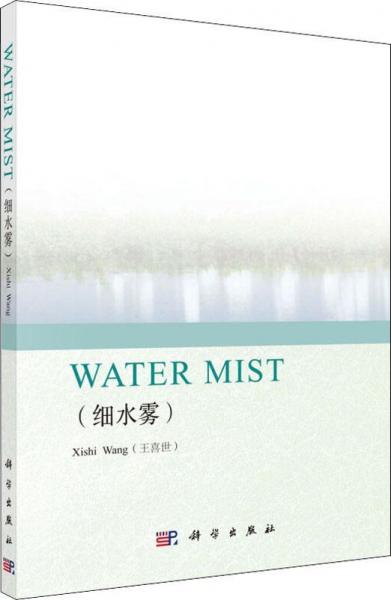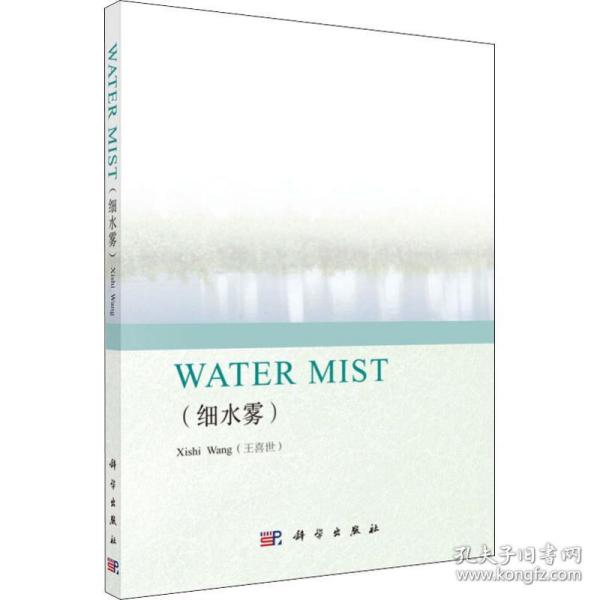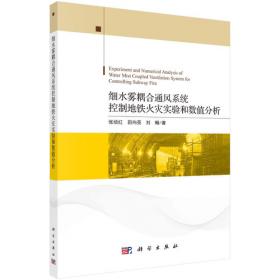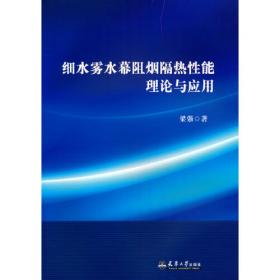细水雾
出版时间:
2019-04
ISBN:
9787030609762
定价:
98.00
装帧:
平装
开本:
其他
页数:
200页
2人买过
-
本书系统介绍了细水雾(Water Mist)发生方法、雾特性实验测量方法,以及细水雾灭火、抑爆、除尘、热防护等方面的基础研究和工程应用的很新进展、发展趋势和面临的挑战。全书既涉及相关理论分析和实验模拟测试,又有模型构建与验证,还包含靠前外主要标准和规范,是对目前世界上细水雾基础研究和技术发展概况及前沿热点的全面阐述和展望。 Chapter 1 Introduction
References
Chapter 2 Basic De.nitions
2.1 Watermist
2.2 Basicvariablesofwatermist
2.2.1 Thecumulativevolumediameter
2.2.2 Sauter mean diameter and others
2.2.3 Spray angle
References
Chapter 3 Water Mist Generation and Spray Characteristics
3.1 Methodsofwatermistgeneration
3.1.1 Impingement nozzle
3.1.2 Pressure jet nozzle
3.1.3 Twin fluids nozzle
3.1.4 Effervescent atomizing nozzle
3.1.5 Effervescent-pressure jet nozzle
3.1.6 Twin fluids-pressure jet nozzle
3.2 Watermistspraycharacteristics
3.2.1 Droplet size distribution
3.2.2 Spray momentum
3.2.3 Spray flux density
References
Chapter 4 Methods of Spray Characterization
4.1 Droplet sizing methods
4.1.1 Phase Doppler particle analyzer
4.1.2 Global rainbow thermometry
4.1.3 Laser diffraction technique
4.1.4 Digital particle image velocimetry
4.1.5 Interferometric laser imaging for droplet sizing
4.2 Measurement of spray flux density
References
Chapter 5 FireSuppressionMechanismsandInfluencingFactors
5.1 Fire suppression mechanisms
5.1.1 Heat extraction
5.1.2 Displacement
5.1.3 Radiant heat attenuation
5.1.4 Kinetic effects
5.1.5 Chemical aspects
5.2 Influencing factors
5.2.1 Types or parameters of the fire
5.2.2 External factors
5.2.3 Additive effects
References
Chapter 6 Explosion Mitigation and Fire Prevention
6.1 Explosion mitigation
6.1.1 Gas/mixtures explosion mitigation
6.1.2 Dust/particle explosion mitigation
6.2 Firepreventionviaradiantheatattenuation
6.2.1 Modelingofthermalradiationshielding/attenuation
6.2.2 Experimentofthermalradiationshielding/attenuation
6.3 Smoke control/removal
6.4 Dust particle removal
References
Chapter 7 ModellingforFireSuppressionwithWaterMist
7.1 Zone model
7.2 Field model
7.3 Spray modelling
7.4 Scaling modelling
7.5 Radiantattenuationmodel
References
Chapter 8 SystemTestsandTypicalApplications
8.1 Typesofwatermistsystems
8.2 Standard fire sources
8.3 Full-scale fire testsoftypicalapplications
References
Chapter 9 Summary
Nomenclature
Colored Picture
-
内容简介:
本书系统介绍了细水雾(Water Mist)发生方法、雾特性实验测量方法,以及细水雾灭火、抑爆、除尘、热防护等方面的基础研究和工程应用的很新进展、发展趋势和面临的挑战。全书既涉及相关理论分析和实验模拟测试,又有模型构建与验证,还包含靠前外主要标准和规范,是对目前世界上细水雾基础研究和技术发展概况及前沿热点的全面阐述和展望。
-
目录:
Chapter 1 Introduction
References
Chapter 2 Basic De.nitions
2.1 Watermist
2.2 Basicvariablesofwatermist
2.2.1 Thecumulativevolumediameter
2.2.2 Sauter mean diameter and others
2.2.3 Spray angle
References
Chapter 3 Water Mist Generation and Spray Characteristics
3.1 Methodsofwatermistgeneration
3.1.1 Impingement nozzle
3.1.2 Pressure jet nozzle
3.1.3 Twin fluids nozzle
3.1.4 Effervescent atomizing nozzle
3.1.5 Effervescent-pressure jet nozzle
3.1.6 Twin fluids-pressure jet nozzle
3.2 Watermistspraycharacteristics
3.2.1 Droplet size distribution
3.2.2 Spray momentum
3.2.3 Spray flux density
References
Chapter 4 Methods of Spray Characterization
4.1 Droplet sizing methods
4.1.1 Phase Doppler particle analyzer
4.1.2 Global rainbow thermometry
4.1.3 Laser diffraction technique
4.1.4 Digital particle image velocimetry
4.1.5 Interferometric laser imaging for droplet sizing
4.2 Measurement of spray flux density
References
Chapter 5 FireSuppressionMechanismsandInfluencingFactors
5.1 Fire suppression mechanisms
5.1.1 Heat extraction
5.1.2 Displacement
5.1.3 Radiant heat attenuation
5.1.4 Kinetic effects
5.1.5 Chemical aspects
5.2 Influencing factors
5.2.1 Types or parameters of the fire
5.2.2 External factors
5.2.3 Additive effects
References
Chapter 6 Explosion Mitigation and Fire Prevention
6.1 Explosion mitigation
6.1.1 Gas/mixtures explosion mitigation
6.1.2 Dust/particle explosion mitigation
6.2 Firepreventionviaradiantheatattenuation
6.2.1 Modelingofthermalradiationshielding/attenuation
6.2.2 Experimentofthermalradiationshielding/attenuation
6.3 Smoke control/removal
6.4 Dust particle removal
References
Chapter 7 ModellingforFireSuppressionwithWaterMist
7.1 Zone model
7.2 Field model
7.3 Spray modelling
7.4 Scaling modelling
7.5 Radiantattenuationmodel
References
Chapter 8 SystemTestsandTypicalApplications
8.1 Typesofwatermistsystems
8.2 Standard fire sources
8.3 Full-scale fire testsoftypicalapplications
References
Chapter 9 Summary
Nomenclature
Colored Picture
查看详情
-
细水雾
正版现货,品相完整,套书只发一本,多版面书籍只对书名
九品
北京市东城区
平均发货25小时
成功完成率89.17%
-
细水雾
正版品相完好,套书和多封面版本咨询客服后再下单
九品
北京市海淀区
平均发货23小时
成功完成率89.86%
-
全新
江苏省无锡市
平均发货14小时
成功完成率87.14%
-
全新
天津市西青区
平均发货15小时
成功完成率91.09%
-
全新
江苏省南京市
平均发货5小时
成功完成率98.35%
-
全新
江苏省南京市
平均发货6小时
成功完成率96.58%
-
全新
山东省泰安市
平均发货25小时
成功完成率90.94%
-
全新
北京市朝阳区
平均发货17小时
成功完成率87.65%
-
全新
河北省保定市
平均发货33小时
成功完成率86.83%
-
 5
5
全新
北京市丰台区
平均发货29小时
成功完成率86.07%
-
全新
北京市通州区
平均发货10小时
成功完成率91.67%
-
全新
四川省成都市
平均发货10小时
成功完成率95.51%
-
全新
广东省广州市
平均发货17小时
成功完成率94.37%
-
全新
北京市西城区
平均发货12小时
成功完成率94.09%
-
全新
北京市海淀区
平均发货9小时
成功完成率97.81%
-
保正版!细水雾9787030609762科学出版社王喜世
1.7天无理由退换货,2.当日16点前订单基本当日发出,最迟隔天,3.天津仓、成都仓、无锡仓、北京仓、广东仓、泰安仓、杭州仓、武汉仓就近发货。4.韵达、中国邮政、圆通、中通随机安排!无法指定快递敬请谅解!5.开票联系客服.
全新
天津市河东区
平均发货25小时
成功完成率88.73%
-
全新
北京市顺义区
平均发货10小时
成功完成率94.21%
-
全新
广东省广州市
平均发货17小时
成功完成率94.16%
-
细水雾
按标题名购买,批量下载图片有时不对应,多本图片为其中一本,有问题请联系客服。
全新
河北省保定市
平均发货28小时
成功完成率89.13%
-
全新
北京市丰台区
平均发货7小时
成功完成率93.13%
-
全新
广东省广州市
平均发货10小时
成功完成率94.86%
-
全新
北京市通州区
平均发货9小时
成功完成率89.19%
-
全新
北京市房山区
平均发货13小时
成功完成率96.84%
-
全新
北京市通州区
平均发货9小时
成功完成率94.44%
-
全新
江苏省无锡市
平均发货8小时
成功完成率96.05%
-
全新
山东省济宁市
平均发货55小时
成功完成率83.12%
-
全新
湖南省长沙市
平均发货34小时
成功完成率85.54%
-
全新
-
全新
北京市海淀区
平均发货16小时
成功完成率88.57%
-
全新
四川省成都市
平均发货22小时
成功完成率78.38%
-
全新
江苏省南京市
平均发货14小时
成功完成率84.18%
-
 2
2
全新
江苏省无锡市
平均发货10小时
成功完成率96.64%
-
全新
江苏省南京市
平均发货8小时
成功完成率51.61%
-
 2
2
全新
上海市浦东新区
平均发货21小时
成功完成率86.09%
-
全新
四川省成都市
平均发货21小时
成功完成率89.94%
-
全新
山东省泰安市
平均发货7小时
成功完成率94.08%
-
全新
北京市海淀区
平均发货8小时
成功完成率94.43%
-
全新
广东省广州市
平均发货7小时
成功完成率89.39%
-
全新
北京市通州区
平均发货36小时
成功完成率87.8%
-
全新
北京市朝阳区
平均发货12小时
成功完成率92.77%
-
全新
北京市通州区
平均发货35小时
成功完成率87.88%
-
 4
4
细水雾
书脊破损已修复,版权页仅一出笔记,内容如新!
八五品
河北省保定市
平均发货7小时
成功完成率90.34%
-
全新
广东省广州市
平均发货8小时
成功完成率88.84%
-
全新
北京市通州区
平均发货26小时
成功完成率89.53%
-
细水雾
正版现货,品相完整,套书只发一本,多版面书籍只对书名
九品
北京市海淀区
平均发货24小时
成功完成率83.23%
-
全新
山东省泰安市
平均发货8小时
成功完成率92.93%
-
细水雾
正版图书。概不议价!请勿催单!急单勿拍!!!套装书请咨询后再拍。小本生意,经营不易,喜欢申请违约金和退款的同行与书友请绕行
全新
湖南省邵阳市
平均发货3小时
成功完成率87.24%
-
全新
广东省广州市
平均发货11小时
成功完成率89.86%
-
全新
北京市通州区
平均发货26小时
成功完成率89.74%
-
细水雾
新华书店全新正版书籍。书名与图片不一致的,以书名为准。个别套装书为单本价格,详情请咨询客服下单。
全新
河北省沧州市
平均发货13小时
成功完成率79.01%

 占位居中
占位居中






























































